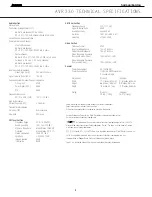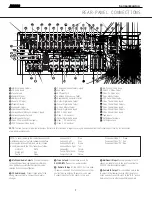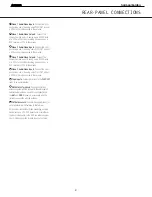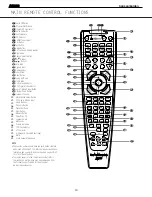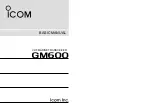
options for the mode group selected. The specific
modes will vary based on the number of speakers
available, the mode group and if the input source is
digital or analog. For example, press the
Surround
Mode Group Selector
7
to select a mode grouping
such as Dolby or Logic 7, and then press this button
to see the specific mode choices available. For more
information on mode selection, see page 26.
9
Tuning Selector:
Press the left side of the button
to tune lower-frequency stations and the right side of
the button to tune higher-frequency stations. When the
tuner is in the Manual mode, each tap will increase or
decrease the frequency by one increment. When the
tuner receives a strong enough signal for adequate
reception,
MANUAL TUNED
will appear in the
on-screen display and the
Lower Display Line
¯
.
When the tuner is in the Auto mode, press the button
once, and the tuner will scan for a station with accept-
able signal strength. When the next station with a
strong signal is tuned the scan will stop andthe on-
screen display and the
Lower Display Line
¯
will
indicate
AUTO TUNED
. When an FM Stereo sta-
tion is tuned, the display will read
A
UTO ST
TUNED
.
To switch back and forth between the Auto and
Manual tuning modes, press the
Tuning Mode
Selector
&
.
)
‹
/
›
Buttons:
When configuring the AVR 330’s
settings, use these buttons to select from the available
choices.
!
AM/FM Selector:
Press this button to turn the
AVR on and to select the Tuner as the input source.
Press it again to switch between the AM and FM fre-
quency bands. (See page 29 for more information on
the tuner.)
@
Set Button:
When making choices during the
setup and configuration process, press this button
to enter the desired setting into the AVR 330’s memory.
#
Digital Input Selector:
Press this button to
select one of the digital inputs or the analog input for
any source. (See pages 26–29 for more information
on digital audio.)
$
Preset Station Selector:
Press this button to
scroll up or down through the list of stations that have
been entered into the preset memory. (See page 29
for more information on tuner presets.)
%
Delay Adjust Selector:
Press this button to
begin the steps required to enter delay settings. (See
page 22 for more information on delay times.)
^
Input Source Selector:
Press this button to
change the input by scrolling up or down through the
list of
Input Indicators
ı
.
&
Tuner Mode Selector:
Press this button to select
Auto or Manual tuning. When the button is pressed so
that
AUTO
appears in the
Lower Display Line
¯
,
the tuner will search for the next station with an accept-
able signal when the
Tuning Selector
9u
is pressed. When the button is pressed so that
MANUAL
appears in the
Lower Display Line
¯
,
each press of the
Tuning Selector
9u
will
increase the frequency. This button may also be used to
switch between Stereo and Mono modes for FM radio
reception. When weak reception is encountered, press
the button so that
MANUAL
appears in the
Lower
Display Line
¯
and on the on-screen display to
switch to Mono reception. Press it again to switch back
to Stereo mode. (See page 29 for more information on
using the tuner.)
*
Optical 3 Digital Input:
Connect the optical digital
audio output of an audio or video product to this jack.
When the input is not in use, be certain to keep the
plastic cap installed to avoid dust contamination that
might degrade future performance.
(
Coaxial 3 Digital Input:
This jack is used for
connection to the output of portable audio devices,
video game consoles or other products that have a
coax digital audio jack.
Ó
Video 4 Video Input Jacks:
These jacks may be
used for temporary connection to the composite or S-
Video output of video games, camcorders or other
portable video products. You may make a connection
to either jack at any time, but not to both simultane-
ously.
Ô
Video 4 Audio Input Jacks:
These audio jacks
may be used for temporary connection to video
games or portable audio/video products such as cam-
corders and portable audio players.
Bass Control:
Turn this control to modify the low-
frequency output of the left/right channels by as much as
±10dB.
Ò
Balance Control:
Turn this control to change the
relative volume for the front left/right channels.
NOTE:
For proper operation of the surround modes
this control should be at the midpoint or “12 o’clock”
position.
Ú
Treble Control:
Turn this control to modify the high
frequency output of the left/right channels by as much as
±10dB.
Û
Channel Adjust Selector:
Press this button to
begin the process of trimming the channel output lev-
els using an external audio source. (For more informa-
tion on output level trim adjustment, see page 30.)
Ù
Volume Control:
Turn this knob clockwise to
increase the volume, counterclockwise to decrease the
volume. If the AVR 330 is muted, adjusting the
Volume Control
Ù
will automatically release
the unit from the silenced condition.
ı
Input Indicators:
The current selected source will
appear as one of these indicators. Note that when the
unit is turned on, the entire list of available modes will
light briefly, and then revert to normal operation with
only the active mode indicator illuminated.
ˆ
Speaker/Channel Input Indicators:
These indi-
cators are multipurpose, indicating both the speaker
type selected for each channel and the incoming data-
signal configuration. The left, center, right, right surround
and left surround speaker indicators are composed of
three boxes, while the subwoofer is a single box. The
center box lights when a “small” speaker is selected,
and the two outer boxes light when “large” speakers are
selected. When none of the boxes are lit for the center,
surround or subwoofer channels, no speaker has been
assigned that position. (See page 20 for more informa-
tion on configuring speakers.) The letters inside each
box displays the active input channels. For standard
analog inputs, only the L and R will light, indicating a
stereo input. For a digital source, the indicators will light
to display the channels being received at the digital
input. When the letters flash, the digital input has been
interrupted. (See page 28 for more information on the
Channel Indicators.)
˜
Upper Display Line:
Depending on the unit’s sta-
tus, a variety of messages will appear here. In normal
operation, this line will show the current input source
and which analog or digital input is in use. When the
tuner is the input, this line will identify the station as AM
or FM and show the frequency and preset number, if any.
¯
Lower Display Line:
Depending on the unit’s sta-
tus, a variety of messages will appear here. In normal
operation, the current surround mode will show here.
˘
Surround Mode Indicators:
The current selected
surround mode will appear as one of these indicators.
Note that when the unit is turned on, the entire list of
available modes will light briefly, and then revert to
normal operation with only the active mode indicator
illuminated.
¸
Remote Sensor Window:
The sensor behind
this window receives infrared signals from the remote
control. Aim the remote at this area and do not block
or cover it.
38
FRONT-PANEL CONTROLS
6 FRONT-PANEL CONTROLS
AVR330
harman/kardon
6
Содержание NOCTURNE 330
Страница 23: ...AVR330 EXPLODED VIEW 23...
Страница 24: ...ue Aug 26 21 18 51 2003 AVR330 harman kardon 24...
Страница 26: ...AVR330 harman kardon...
Страница 27: ...AVR330 harman kardon 27...
Страница 28: ...AVR330 harman kardon...
Страница 29: ...AVR330 harman kardon...
Страница 30: ...CAM350 PRO V 7 6 Mon Sep 01 10 29 56 2003 Untitled 30 AVR330 harman kardon...
Страница 31: ...M350 PRO V 7 6 Mon Sep 01 10 59 10 2003 Untitled AVR330 harman kardon 31...
Страница 73: ...AVR330 harman kardon 73...
Страница 74: ...AVR330 harman kardon 74...
Страница 75: ...AVR330 harman kardon 75...
Страница 76: ...LC74763 74763M Pin Assignment Serial Data Input Timing No 5039 4 19 Top view AVR330 harman kardon 76...
Страница 78: ...No 5039 5 19 System Block Diagram LC74763 74763M AVR330 harman kardon 78...
Страница 84: ...AVR330 harman kardon 84...
Страница 86: ...AVR330 harman kardon 86...
Страница 87: ...AVR330 harman kardon 87...
Страница 100: ...AVR330 harman kardon 100...
Страница 111: ...AVR330 harman kardon 111...
Страница 112: ...AVR330 harman kardon 112...
Страница 113: ...MAIN BOARD 1 AMP AVR330 harman kardon 113...
Страница 114: ...MAIN BOARD 1 AMP AVR330 harman kardon 114...
Страница 115: ...MAIN BOARD 1 AMP AVR330 harman kardon 115...
Страница 116: ...VIDEO BOARD AVR330 harman kardon 116...
Страница 117: ...VIDEO BOARD AVR330 harman kardon 117...
Страница 118: ...VIDEO BOARD AVR330 harman kardon 118...
Страница 119: ...FRONT BOARD AVR330 harman kardon 119...
Страница 120: ...FRONT BOARD AVR330 harman kardon 120...
Страница 121: ...FRONT BOARD AVR330 harman kardon 121...
Страница 122: ...MAIN BOARD 2 BIAS REGULATOR AVR330 harman kardon 122...
Страница 123: ...INPUT BOARD 1 ANALOG AVR330 harman kardon 123...
Страница 124: ...INPUT BOARD 1 ANALOG AVR330 harman kardon 124...
Страница 125: ...INPUT BOARD 1 ANALOG AVR330 harman kardon 125...
Страница 126: ...INPUT BOARD 2 DIGITAL AVR330 harman kardon 126...
Страница 127: ...INPUT BOARD 2 DIGITAL AVR330 harman kardon 127...
Страница 128: ...INPUT BOARD 2 DIGITAL AVR330 harman kardon 128...
Страница 129: ...WIRING DIAGRAM AVR330 harman kardon 129...




